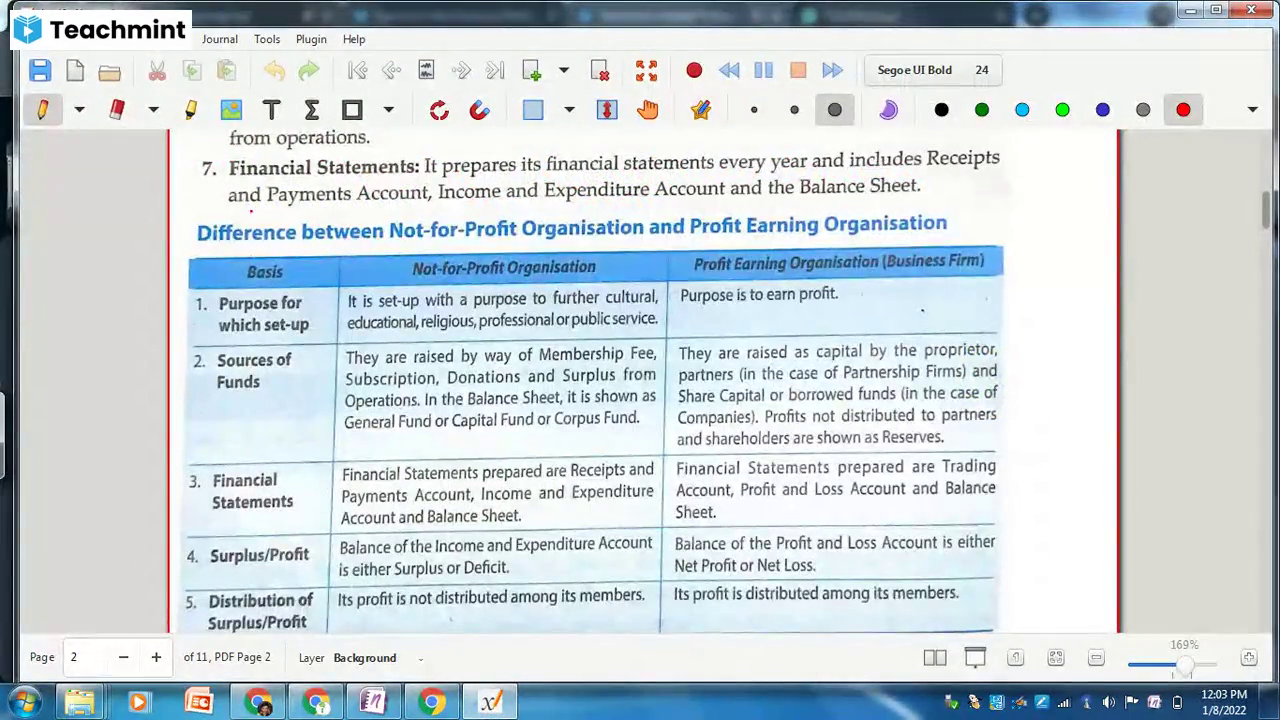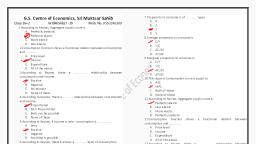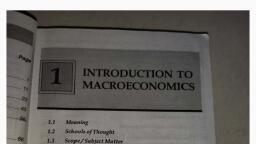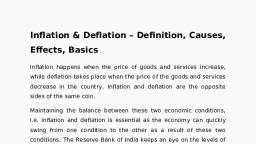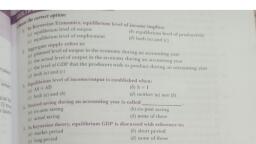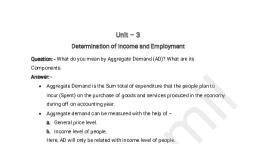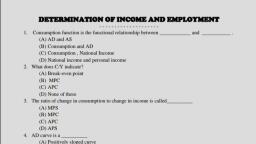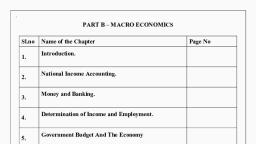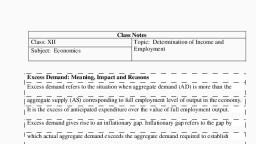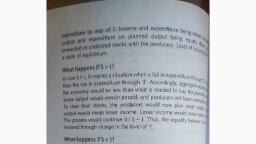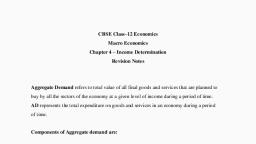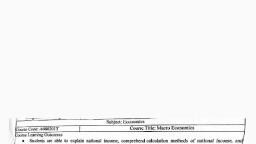Page 1 :
Concept of AD (Aggregate Demand), Components of AD (Aggregate Demand), Concept of AS (Aggregate Supply), , Saving Function and Propensity to Save, , ONCEPT OF AD (AGGREGATE DEMAND), , ving observations need to be noted to understand the concept, ) in Macroeconomics:, , service) in the markets. It refers to demand for all goods and, Services in the economy. 7, , AD does not refer to the demand for any particular good (or, , AD is often measure, Sa flow concept., , AD can be m, the economy,, People. lf AD, NeBative relat;, Curve Slopes, , d for the period of an accounting year. So, it, ———, , €asured (a) with reference to general price level in, Or (b) with reference to the level of income of the, , is related to the general price level" we Shall find, onship between price level and AD. So that, AD _, © level downward. On the other hand, if AD is related to, rae a ee we shall find Positive relationship between, NTE tevel 8 aula eee ae Lof, , ' ly Only in relation to the leve, mote So that, AD rises as the level of i, , omy,, , Consumption Function with reference to Propensity to Consume, , Relationship between Propensity to Consume and Propensity to Save, , , “f Bhs, , Bev ter, , al at el, , eC, t, , ncome rises in the as«-<—~
Page 2 :
\w) AD is measured not as the sum total of Physical qy ", , goods demanded in the economy. In fact, itis not possibney: uf, , é, 56. AD is always measured in terms of total expend, . 5 Aways . ~smcmemne lle 6, goods and services. \ sole ORY,, , , , , \S /, Vr. ev (vi) AD is always expressed as what people wish to speng o, Yor _ people plan to spen fferent levels of income, Never te, vy 9 = AD as what people actually sper on the piitchase of 800d re, “Os services in the economy. a, is! | With these observations in mind, we may define AD as Under:, , , , , , , , “AD is the s, , um total of expenditure that the people plan to incur on the burchase, 6, tng ya), , , , , , goods and ser vices produced in the economy (during the period of an acco, corresponding to their different levels of income,, , , , , , , , ADis never zero even, when Y (income) = 0., Because: Some, expenditure is always, essential for survival. This, is incurred even when, income is zero. This is, done either by using, the past saving or by, , ing., , , , , , Behaviour of AD: AD Schedule, , Since AD is measured in terms of aggregate expenditure (, purchase of goods and services) in the economy, 0, , ON the, behaviour of AD, is studied in terms of the behaviour of aggregate expenditure, , different levels of Y (income). Thus, behaviour of AD mean hy,, aggregate expenditure (AE) responds to different levels of Y in the, economy. This ‘is expressed by way of a schedule, known as Ap, schedule or AE schedule. Table 1 is an example of this schedule., , , , Table 1. AD Schedule showing relationship between AD and Y, , , , “, , a, , Sf, , fitroductory Macrovr ONOMICS, , 78, , , , , , , , i 4 Oo [ vi ap, 7 sie AE or Planned Expenditure), 0 ~* 30, 20, 35, 40 40 =, 60, aS af 4, 80 500 |, 100 55 |, 120 60 _|, , , , , , Table 1 offers following observations:, (i) There is always some minimu, economy even when Y = 0. T, , reason is simple: you must incu, for your survival, ev, You may, , m level of expenditure in the, hus, AD = 30 when Y = 0. The, r some expenditure to buy goods, en when your income (Y) is absolutely zero, At iateoseer a borrowing, called negative saving. ,, creases. Thus, AD is positively related toy., , fr, , (ii)
Page 3 :
ain level of Y is reached, AD lags behind y, Thus,, , , , a cert nee ees, (ill) naw 3 ~ 60, AD = 45. Likewise, when Y = 80, AD = 50. This, wn ereBETAUIE: at higher levels of Y, people start saving a part, nape” cee emarmmininatn &, of their income,, ees” «, AD curve, 4 shows AD curve. It is a diagrammatic presentation of AD, = _, gchedule. J (y/, y AD In relation to Y (Income) y/ 9, a a ,, ¢ Y ) J A é, yr’, V } 8 J ,, C \ ), 2, LY, , , , , , O60 4060 80-100 120, Y (Income)/GDP, , = @ 45° line indicates the level of Y, as shown on the X-axis., , @ AD=Yat point E, when Y = 40., , @ | Prior to it, AD > Y. This is because of the impact of minimum, level of AD., , @ Beyond it, AD <Y, This is because at higher levels of Y,, people start saving a part of their income., , @ Minimum level of AD = 30,, This indicates expenditure independent of the level of, income in the economy., , AD starts from 30 on the Y-axis. It suggests minimum level of, expenditure, or expenditure which is independent of the level of Y in, the economy. E is the point where AD = Y. Prior to it, AD > Y. This, is because of the impact of minimum level of AD. Beyond point E,, AD <. This is because at higher levels of income, people tend to save, 2 part of their income. Generally, AD increases as Y increases., , AD schedule is a table showing AD (or aggregate expenditure) corresponding to different levels o, incorne (Y) in the economy. AD is positively related to Y. However, there is always some minin, of AD even when ¥ = O. At higher levels of Y, AD lags behind Y, Because, people start saving ., , , , , , part of their income., AD curve is, 4 diagrammatic presentation of AD schedule, showing AD cotresponding to «, levels of Y in the economy, It tends to slope upward, showing positive relationship betwee, , differer, , , , andy
Page 4 :
|, , ONENTS OF AD (AGGREGATE PEMAND, i, , OMP., 2. ¢ aggregate expenditure) are discussed, , AD (or, Samant closed economy, and (2) open economy, a det, reference !, , discussion is as under:, , With, ailey, , (1) Components of AD ina Closed Economy, , i seclor closed ec ‘, A closed economy may be: (i) two sector close de onomy, or (i) te, , F onomy., sector closed ecot . |, i s: (i) househol, A two sector closed economy includes: (i) d sector, ., , (ii) producer sector. Specifically, there is no Seven Sector in thg, economy. Households purchase goods for en oO Consumption, Accordingly, their expenditure is called consumption expenditure (c), Producers, on the other hand, purchase goods for purpose f, investment.. Accordingly, their expenditure is called investment, expenditure (I). Thus, in a two sector closed economy, AD has tng, , components as these:, , = € + I, vt * k k, Aggregate Household Producers This is equal to, Demand Consumption Investment Private Investment, ' Expenditure Expenditure} Expenditure, as there, , is NO government sector, , A three sector closed economy includes: (i) household Sector,, (ii) producer sector, and (iii) government sector. The government makes, ‘collective Consumption expenditure’. It refers to public consumption, expenditure or consumption expenditure on behalf of the society, as ‘a Whole. (Example: Government expenditure on the purchase, of food and clothes for the defence forces.) Also, the government, makes “investment expenditure, such as expenditure on roads and, bridges. The total government expenditure (including government, consumption expenditure and government investment. expenditure), , is indicated by G. So that, in a three sector closed economy, there até, three components of AD, as these:, , AD = C ; ' :, , Dean usetiald Private Government, a Consumption Investment Expenditure, Ppenditute, Expenditure (including both, , || as, consumption as vel, investment expend!
Page 5 :
si), , | Ve ponents of AD inan Open Economy =~", 0!, , conomy includes four sectors: (i) household sector,, e, , op, i producer secton, (it, ecto e world sector generates demand for our goods and services, , pest 0 a our exports. Thus, exports add to AD in the domestic, rms But, we also make imports from rest of the world. Imports (M), , osite to exports (X). While exports increase AD in the domestic, are OPPO= == ts_decrease it. Accordingly, we find the value of, , con (x - M). It is this value which contributes to AD in the, , (iii) government sector, and (iv) rest of the world, , , , , exports :, , Bt economy. Accordingly, we have four components of AD in, : open economy, as these:, , a eG + K-M), Aggregate Household Private Government Net, Sand Consumption Investment Expenditure Exports, , Expenditure Expenditure (including government, , consumption expenditure, and government, investment expenditure), , AD=C+1+G+(X-M) FOCUS, , , , , , , , , , 3. CONCEPT OF AS (AGGREGATE SUPPLY), , Concept of AS, , AS (aggregate supply) refers to aggregate production as planned by, the producers during an accounting year. It implies the flow of goods, and services in the economy during an accounting year. We know,, production of goods and services implies ‘value addition’, and value, addition implies ‘income generation’. Our knowledge of national, income accounting tells us that ‘value added’ and ‘income generated’, are identical to each other. Accordingly, AS implies flow of income (Y), in the economy during an accounting year. AS and Y, therefore, can, be treated as identical to each other., , , , , , , AS refers to flow of goods and services as planned by the producers during an accounting year. It is, identical with the flow of income (Y) during an accounting year. AS and Y, therefore, may be treated, a8 identical to each other., , ———, , Aggregate Demand, Aggregate Supply and Related Concepts 181






